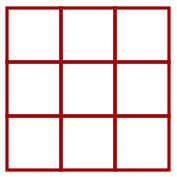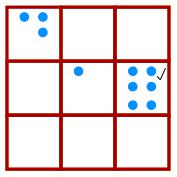Or search by topic
Number and algebra
Geometry and measure
Probability and statistics
Working mathematically
Advanced mathematics
For younger learners
Dotty Six



- Problem
- Student Solutions
- Teachers' Resources
Dotty Six
Watch this video to see the game being played.
Can you work out the rules?
You need a partner, a $1$-$6$ dice and a grid like this;

Take turns to throw the dice and draw that number of dots in one of the boxes on the grid.
Put all of your dots in one of the boxes. You can't split them up and you can't have more than six dots in a box.
When a box is full, you could put a tick in the corner like this:

Keep going until there are three ticks in a row or column or diagonal. The winner is the person who puts the last tick.
Now, can you change the game to make your own version?
Why play this game?
The game as introduced is intended for KS1 children who are just beginning to become confident with small numbers. However there are many variations, some suggested below, that make it suitable for older children. As with many of the NRICH games, consolidation of basic number facts is combined with an element of strategic thinking.
Possible approach
With very small children you may wish to play the game with a small group first before encouraging them to play in pairs.
If you have access to a projector and screen, you may wish to use the PowerPoint presentation with older children and click through in your own time. (This version of the PowerPoint file uses blue dots on the grid so that it is not possible to distinguish between each player's dots.) If that is not possible, choose a child or another adult to play the game with you somewhere where everyone can see what's going on. The children watch in silence, having been prompted to watch closely to see if they can work out what the rules of the game are. You may need to show the animation more than once. You can find some Dotty Six grids here as a Word or a pdf file for recording the results of the game.
Take suggestions about what the rules may be, perhaps recording them centrally once everyone has agreed. They are:
- take turns to throw the dice and put the dots into a box
- you can put your dots anywhere but you can't have more than six dots in any one box
- you have to put all your dots in one box
- you win if you finish the line, row or diagonal of complete boxes
- if you can't go you miss a turn.
When everyone has played a few times, you can change the game:
- by making the total different (10, 12, 15, 20)
- by giving different dice (with only even numbers, only odds, dice to 10 etc)
- by making the grid bigger (4 by 4)
You may also like to read the article Developing the Classroom Culture: Using the Dotty Six Activity as a Springboard for Investigation which suggests focusing on the game in a staff meetingto support the development of classroom culture across the school.
Key questions
Where will you put your dots? Why?
How do you know where to put your dots?
How many more do you need to win?
Possible support
Small children can use multilink or counters, or Numicon, on a large grid (available as a Word document or pdf), rather than recording with dots on a small one. They could begin with six counters in each box and take away the number thrown on the dice.
Possible extension/adaptation
This is a great game for children to use their creativity and to work at a level at which they feel comfortable. The sophistication of their recording will change with their confidence.
Provide a range of dice including blank ones. They could:
- change the total in each box
- make the winner the first to complete a whole row that adds to a certain total (e.g. 20)
- change the shape of the grid (triangles rather than squares perhaps)
- use a different sort of number - fractions, decimals, percentages ...
- change the rules completely.
- Start with nine cards, three depicting one dot, three depicting two dots and three depicting three dots. Invite children to arrange the nine cards in a square of three by three and talk about what they see. Explore different arrangements of the cards in a three by three square, and continue to invite comments and observations. This could lead into a version of Dotty Six in which a 1/2/3 dice is thrown and children pick up an appropriate card, or draw their own dots, perhaps aiming for a particular total in a line of three, rather than in each cell. (This is inspired by Marion Bird's book Mathematics for Young Children: An Active Thinking Approach.)
- Use a dice that includes a blank face, or a zero. Let learners decide what they will do when the blank or zero is rolled.
- Set up a large three by three grid on the floor of the classroom or school hall using tape, or use chalk outside. Invite the children themselves to stand in an appropriate cell when the dice is rolled. Give everyone the opportunity to be an observer/director (!) and a participant in the grid as the different roles will offer different perspectives on the game.
- Prepare some small Post-it notes with different representations of numbers, for example dot patterns, numerals - you can tailor your representations and the size of the numbers to suit your learners. Children can then roll an appropriate dice and select a Post-it to place on the grid, rather than having to create the representation themselves. (Laminating the Post-its will mean you can re-use them on multiple occasions.)
- Use large whiteboards if you have them (for example A3 size) to draw the the grid on. This makes it much easier for you as the teacher to observe from a distance and still see what learners are discussing.
Related Collections
You may also like
Biscuit Decorations
Andrew decorated 20 biscuits to take to a party. He lined them up and put icing on every second biscuit and different decorations on other biscuits. How many biscuits weren't decorated?

